
The politics of Latvia takes place in a framework of a parliamentary representative democratic republic, whereby the Prime Minister is the head of government, and of a multi-party system. The President holds a primarily ceremonial role as Head of State. Executive power is exercised by the government. Legislative power is vested in both the government and parliament, the Saeima. The Judiciary is independent of the executive and the legislature. The Economist Intelligence Unit rated Latvia a "flawed democracy" in 2022.
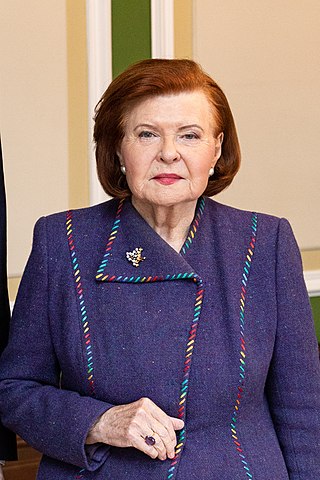
Vaira Vīķe-Freiberga is a Latvian politician who served as the sixth President of Latvia from 1999 to 2007. She is the first woman to hold the post. She was elected President of Latvia in 1999 and re-elected for the second term in 2003.
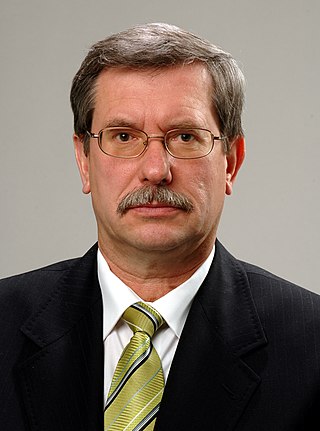
Indulis Emsis is a Latvian biologist and politician. He was Prime Minister of Latvia for ten months in 2004, the first Green politician to lead a country in the history of the world. He was Speaker of the Saeima, the Latvian parliament from 2006 to 2007. Emsis' political views are described as rather conservative, unusual for members of green parties around the world.

Ingrīda Latimira, formerly Ingrīda Ūdre, is a Latvian politician who belongs to the Latvian Farmers' Union political party.

A presidential election was held in the Latvian Saeima on 31 May 2007. The government candidate Valdis Zatlers defeated Aivars Endziņš.

The president of Latvia is head of state and commander-in-chief of the National Armed Forces of the Republic of Latvia.

Vaira Paegle was a Latvian politician. She was a Deputy of the Saeima and a member of the People's Party, later of the Civic Union.
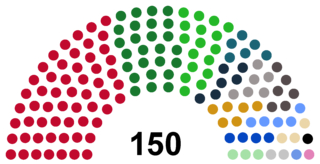
The Constitutional Assembly of Latvia was independent Latvia's first elected legislative body. Its main task was creating the constitution of Latvia, the Satversme, which is still in effect to this day. The Speaker of Assembly was Jānis Čakste, who later became the first President of Latvia. The assembly functioned from May 1, 1920, until November 7, 1922, when the 1st Saeima convened.

Indirect presidential elections were held in Latvia on 20 June 2003. The incumbent, Vaira Vīķe-Freiberga, was re-elected by the Saeima to serve a second four-year term with an overwhelming majority.

Pauls Kalniņš was a Latvian physician and politician (LSDSP), a long-term Speaker of the Saeima, one of the signatories of the Memorandum of the Central Council of Latvia in 17 March 1944, and was the Acting President of Latvia.

Courland is one of the five multi-member constituencies of the Saeima, the national legislature of Latvia. The constituency was established in 1922 when the Saeima was established following Latvia's independence from the Soviet Union. It consists of the cities of Liepāja and Ventspils and municipalities of Kuldīga, Saldus, South Kurzeme, Talsi and Ventspils in the region of Courland. The constituency currently elects 12 of the 100 members of the Saeima using the open party-list proportional representation electoral system. At the 2022 parliamentary election it had 180,070 registered electors.

Latgallia is one of the five multi-member constituencies of the Saeima, the national legislature of Latvia. The constituency was established in 1922 when the Saeima was established following Latvia's independence from the Soviet Union. It consists of the cities of Daugavpils and Rēzekne and municipalities of Augšdaugava, Balvi, Krāslava, Līvāni, Ludza, Preiļi and Rēzekne in the region of Latgallia. The constituency currently elects 13 of the 100 members of the Saeima using the open party-list proportional representation electoral system. At the 2022 parliamentary election it had 194,825 registered electors.

Riga is one of the five multi-member constituencies of the Saeima, the national legislature of Latvia. The constituency was established in 1922 when the Saeima was established following Latvia's independence from the Soviet Union. It consists of the city of Riga and overseas voters. The constituency currently elects 36 of the 100 members of the Saeima using the open party-list proportional representation electoral system. At the 2022 parliamentary election it had 565,297 registered electors.
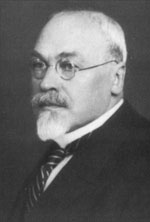
The 1927 presidential elections in Latvia took place in April 5, 7, and 8, 1927, during the term of the 2nd Saeima. The elections took place in extraordinary circumstances, as the former President of Latvia, Jānis Čakste, had died while holding the office of President. The election of the president this time proved to be very difficult as only after nine unsuccessful votes in three Saeima sittings for the 2nd President of Latvia was Gustavs Zemgals elected.

The 1930 presidential elections in Latvia took place in April 8 and 9, 1930, during the term of the 3rd Saeima. Incumbent president Gustavs Zemgals refused to run again, so, like in the 1927 elections, many rounds of voting were required until the Latvian Farmers' Union candidate Alberts Kviesis was elected president and became the 3rd President of Latvia.

The 1933 presidential elections in Latvia took place on April 4, 1933, during the term of the 4th Saeima. In the first round of voting, incumbent President Alberts Kviesis was re-elected President.

Livonia is one of the five multi-member constituencies of the Saeima, the national legislature of Latvia. The constituency was established in 1922 when the Saeima was established following Latvia's independence from the Soviet Union. It consists of the city of Jūrmala and municipalities of Ādaži, Alūksne, Cēsis, Gulbene, Ķekava, Limbaži, Madona, Mārupe, Ogre, Olaine, Ropaži, Salaspils, Saulkrasti, Sigulda, Smiltene, Valka, Valmiera and Varakļāni in the region of Livonia. The constituency currently elects 26 of the 100 members of the Saeima using the open party-list proportional representation electoral system. At the 2022 parliamentary election it had 396,278 registered electors.

Ojārs Ēriks Kalniņš was a Latvian politician and diplomat who served as a member of the Saeima (2010–2021), head of the Latvian Institute (1999–2010), and as Ambassador to the United States (1993–1999). Born in a displaced person's camp in Germany to parents escaping the Soviet occupation of Latvia, he spent his early career working for various Latvian-American organizations before moving to Latvia and taking part in the restoration of Latvian independence. In 1998, he was awarded the Order of the Three Stars.
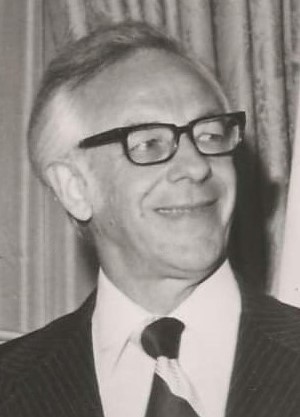
Gunārs Meierovics was a Latvian politician and the youngest son of the second Prime Minister of Latvia Zigfrīds Anna Meierovics. Meierovics was also a candidate for the 1993 Latvian presidential election.
Arnis Kalniņš was a Latvian economist, academic, and politician. He served as the Minister for Economic Reforms of Latvia from 1991 to 1993, President of the Mortgage and Land Bank of Latvia from 1993 to 1996, and a deputy of the 7th Saeima. He was a full member of the Latvian Academy of Sciences.





















